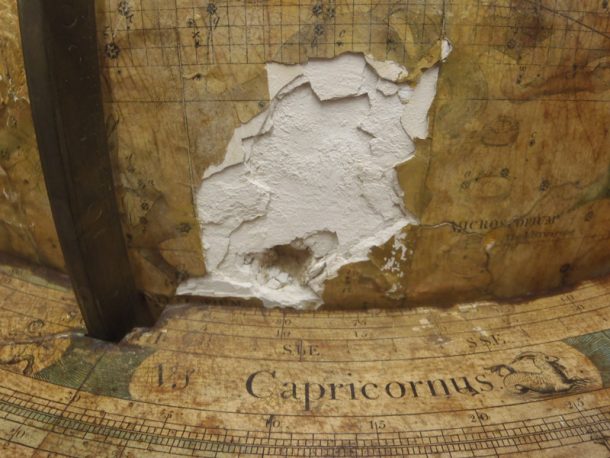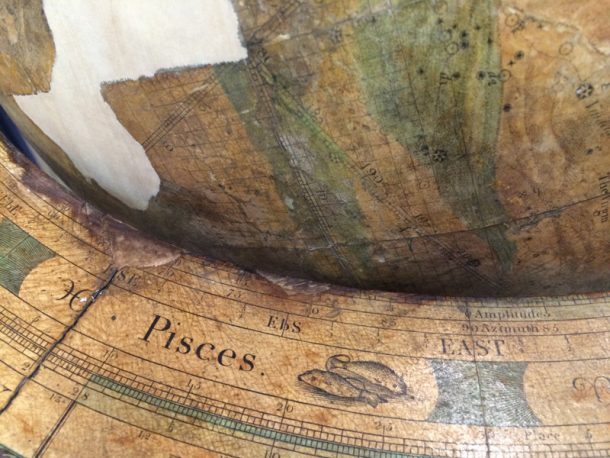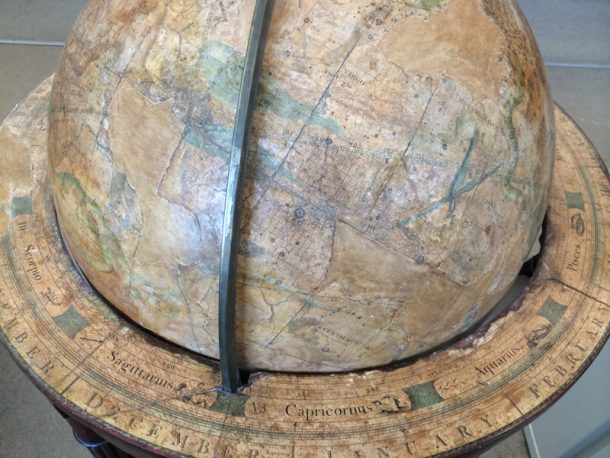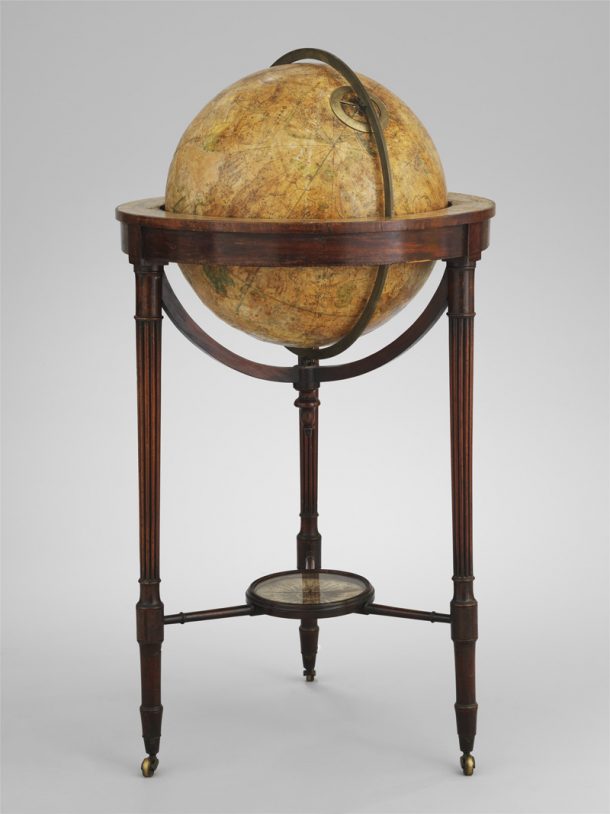by Susan Catcher, Senior Paper Conservator, and Zoe Allen, Head of Furniture Conservation
The celestial globe (W.52-1916) is an 18” (46cm) globe and is one of a pair, the other being a terrestrial globe (W.52a-1916). They were made by the London-based Bardin family of globe makers who began globe production in the 1780s, and from 1799 manufactured ‘New British Globes’ that depicted the latest geographic and astronomic discoveries, rendering all earlier globes obsolete. Both globes are inscribed at the South Pole with dedications from ‘W & J. M. Bardin’ to the Rev. Nevil Maskelyne, Astronomer Royal (celestial globe) and to the Rt. Honorable Sir Joseph Banks, President of the Royal Society (terrestrial globe). The celestial globe underwent conservation treatment prior to going on display in the V&A’s autumn 2017 exhibition, ‘Opera: Passion, Power and Politics’.
The celestial globe is likely to have been constructed of two semi hemispheres of paper or thin board gores (triangular shaped pieces of printed paper calculated to join together to form a semi hemisphere of a specific size of globe) formed over a mould and joined to make a sphere at the equator (Figure 1). A plaster-like material was applied over the paper sphere and that then was overlaid with printed and hand-coloured paper globe gores. Over 6ooo stars, star clusters and planets were calculated in position for the beginning of the nineteenth century. It is supported internally by a wooden cross structure attached to the sphere with small pins at the equator. Weights would have been placed inside to balance the globe. The sphere is supported in a varnished mahogany stand with three reeded legs on brass castors, jointed with three straight stretchers meeting at the centre in a circular panel fitted with a large compass.

The condition of the globe was poor and there were large losses down to the plaster core due to previous impact damage. The paper had lifted at some of the gore edges and the globe’s surface had been unevenly vanished, probably at a later date, with shellac (a resin secretion from a beetle that lives on an Indian tree), which had darkened. This was followed by a wax layer, added at a later date, which had become ingrained with dirt, obscuring the beautiful celestial images. Previous restorations were unsympathetic in both structure and colour and overlapped the original. The laid paper compass held in a circular frame at the base was planar distorted and badly stained, rendering the information indistinct. The mahogany frame was stable with some small losses to the veneer. The non-original glass over the compass had been poorly cut with rough edges and was not fixed in place.
Flaking plaster was consolidated with Lascaux Medium for Consolidation and losses were coated with an isolation layer of Paraloid B72 in acetone (50:50) with IMS. Deeper areas of loss were filled with a first application of Flugger, an acrylate filler, followed by several layers of gesso (calcium carbonate mixed with rabbit skin glue 1:12). In order for the loss to be filled almost to the surface while leaving enough depth for the new paper insert, the shape of the loss was traced onto a piece of the same acid free card to be used for repair, lined with 220 mic Melinex film, sunk into the wet fill, then removed when dry. Fills were further smoothed with fine grade abrasive papers, ‘pens’ and scalpels (Figure 2).

Some old plaster fills were reshaped and excess that was covering the original print was removed by slightly humidifying and careful dry scraping. Areas of unsightly yellow in-painting were removed with Biostrip, a non-toxic paint remover. The surface was lightly cleaned with white spirit to remove the later wax layer. It was decided not to remove the darkened shellac varnish as a test sample using Industrial Methalated Spirits bleached the hand colouring.
The paper infills were created from previously stretched and toned acid-free archival end leaf paper, then toned with Windsor and Newton watercolours. The uneven application of the shellac varnish meant that the paper was initially coloured to a lighter tone to enable more precise in-painting to take place later. The missing areas were traced and the shape pricked out using an awl through the tracing paper onto the toned end leaf paper. The pricking-out line followed the outside of the drawn line, but when the line corresponded to the straight edge of a globe gore, it was accurately knife cut. The resulting tiny holes are akin to postage stamp perforations and can tear to the exact shape required. The edges of the slightly oversized infill were chamfered from the back to remove the uneven perforated edge and thin the paper. The infill was then adhered with wheat starch paste to the corresponding missing area, with the thinned edge minutely overlapping the original paper and the knife cut edge abutting.
Overpainting the new paper infills was essential to create a cohesive look. The hand colouring and shading of the shellac varnish meant that each repair had to be assessed and decisions made as to the predominant pigment. Some areas of the grey and green hand-colouring had to be acknowledged without adding unknown detail. Once all fills were complete, the matt varnished surface was recreated (Figure 3). A 20% solution of acacia gum and water was made and tested but it was too viscous and caused the paper to curl, making the wrong refractive quality. A 10% solution of acacia gum and water produced the best results so was brushed over the toned infills and allowed to dry before a second coat was applied. Any repair edges with minor lifting were re-adhered with wheat starch paste.

Losses to the wooden veneer in the globe stand were filled with gesso, smoothed and toned to match the surrounding wood. The brass meridian ring denoting measurements of latitude and the hour rings positioned at each pole were cleaned with white spirit. The laid paper compass was removed from its frame and surface cleaned with a grated Mars eraser. The black ink was tested for fugitivity before the paper was washed for two hours in cold water then air-dried. It was then re-humidified and flattened before being placed over Melinex to provide a barrier between it and the mahogany stand. The glass covering the compass was replaced with low reflective Artglass UV 2mm and a new wooden molding was tailor-made to secure the glass in position (Figure 4).

References
http://www.jstor.org/stable/23993602
Sumira S., Secrets of the Inner Globe, Globe Studies No.51, International Coronelli for the Study of Globes, pp.133-140. Accessed 22 February 2017.
Millburn JR. and T.Rossaak., The Bardin Family, Globe-Makers in London, and their associate, Gabriel Wright, pp. 21-66. Accessed 22 February 2017.
Masschelein-Kleiner L., Ancient Binding Media, Varnishes and Adhesives, ICCROM Rome 1995 pp.50 and 78
McClintok T., Bigrigg L. and LaCamera D., Case Study: conservation and restoration of a pair of large diameter English globes, Journal of the Institute of Conservation Vol 38, Number 1, Routledge 2015 pp. 77-91
Acknowledgements
Thanks to Yukiko Barrow for making the new moulding holding the glass in place.
Opera: Passion, Power and Politics runs until Sunday, 25 February 2018.



What an amazing work! I really admire you!
Thanks for another informative web site.